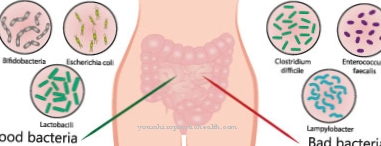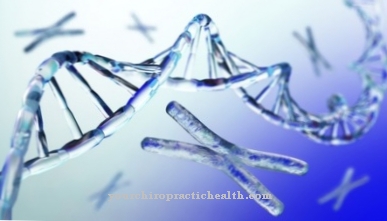The Lyme disease or Lyme disease is an infectious disease that is mainly transmitted by ticks or wood ticks and triggered in humans. The causative bacteria are the so-called Borrelia.
What is Lyme disease?

Lyme disease, or commonly known as borreliosis, is an infection with the bacterium Borrelia burgdorferi or related species.
The name of the disease transmitted by tick bites, which is blamed for a variety of different, sometimes serious symptoms, is made up of the name of the town of Lyme in the US state of Connecticut, where Lyme disease was first described in 1975, and the name of the French Borrel bacteriologists together.
In 1982 the bacteria named Borrelia burgdorferi below were detected and cultivated for the first time by the Swiss Willy Burgdorfer.
causes
Lyme disease is transmitted through tick bites. In Europe, the common tick (also known as ticks) is considered to be the main carrier of Lyme disease. In parts of southern Germany, up to 50% of ticks are contaminated with the pathogen. The longer the tick stays in the skin, the greater the risk of infection.
About a quarter to half of all people infected with the pathogen actually develop Lyme disease.
The number of infections is also increasing in Northern Europe, for which climate changes, but also increased awareness of the disease are blamed.
Symptoms, ailments & signs
Lyme disease can be difficult to recognize because it does not necessarily have to cause symptoms in the early stages. The disease usually has three stages:
- step 1
The first sign of Lyme disease can be wandering redness (erythema migrans) near the site of the bite a few days or weeks after a tick bite, possibly associated with flu-like symptoms, headache / body aches and fever. The symptoms can easily be confused with a summer flu. As a precaution, the bite site should be observed for a while.
- Level 2
The pathogens reach various organs via the bloodstream and can cause discomfort where they settle, in children often meningitis or paralysis of the facial or neck nerves. In general, the pathogens can cause pain and paralysis in the nerves and cause inflammation and conduction disorders in the heart.
- level 3
After months to years, Lyme disease can cause joint inflammation in the affected joints (Lyme arthritis), mostly in the knee joint. The pain can appear in bouts, but it can also persist permanently. There may be bluish discoloration of the skin on the arms and legs. Another symptom can be chronic inflammation of the spinal cord and brain with paralysis as a long-term consequence. In the worst case, the disease can become chronic.
course
Since Lyme disease can affect all organs and is often "hidden" in connective tissue or joints, a large number of rather unspecific symptoms can occur. But there are also typical signs: For example, erythema migrans, the wandering redness that occurs around the puncture site within days to weeks, is characteristic of the local infection and thus the first stage of the disease.
In the second stage, the pathogen spreads and then spreads over the entire body. In the beginning, Lyme disease often comes with the typical symptoms of a flu-like infection. With neuroborreliosis, paralysis of the facial muscles and severe nerve pain can occur. When a joint is affected, those affected have "jumping" joint pain and recurring inflammation in one or more joints, known as Lyme arthritis.
Heart muscle inflammation can also be traced back to Lyme disease. The third stage of the disease is characterized by the chronification and worsening of the above symptoms. Even after long symptom-free periods, recurrent meningitis and irreversible nerve damage can occur.
Complications
In Europe and North America, borreliosis is usually Lyme borreliosis. Other borreliosis, such as relapsing fever, occur almost exclusively in the tropics. If left untreated, Lyme borreliosis can lead to significant complications, which are difficult to treat in the late phase because the triggering Borrelia often not only hide from the immune system, but also cannot always be detected by treatment with antibiotics.
If the bacteria manage to get into the bloodstream after infection, they can spread in the body and mainly affect joints, heart, nerves and meninges, with a sometimes unfavorable prognosis. Above all, the fact that the blood-brain barrier can be crossed for them can lead to the development of so-called neuroborreliosis.
The disease is associated with irreversible, serious sensory and movement disorders, some of which take years to set in. The Post Lyme Borreliosis Syndrome, which is called chronic fatigue syndrome in Anglo-Saxon parlance, is also being discussed. However, the symptoms are non-specific and can also be caused by other illnesses or deficiency symptoms.
With an early treatment of Lyme disease with antibiotics, which is initially noticeable as a circular erythema around the tick's puncture site, the chances of success are good. Further complications are then no longer to be feared.
When should you go to the doctor?
The symptoms of Lyme disease are non-specific and do not always point directly to the disease. If, a few days to a few weeks after a tick bite, a circular red spot appears near the puncture site, which is warm to the touch and increasingly spreading, a doctor should be consulted immediately. Even if this characteristic symptom is missing, it is advisable to seek medical advice in the case of unclear fever, severe and recurring joint pain and headache, and swollen lymph nodes.
This applies not only if a previous tick bite is known, but also if there is a mere suspicion that an infection may have occurred. If numbness, sensory disturbances and symptoms of paralysis occur in the hands, legs or face, the route should also lead to the doctor as soon as possible.
In the weeks after a tick bite, even inconspicuous symptoms can give the first indications of Lyme disease: In order to diagnose an infection at an early stage, a visit to a doctor is advisable, even if you are unusually tired, irritable or if you feel generally ill.
At the latest in the second stage of the disease, which is often accompanied by inflammation of the nerves, extensive redness, massive joint swelling and in some cases psychological impairment, medical help must be sought immediately in order to avoid serious complications.
Doctors & therapists in your area
Treatment & Therapy
The diagnosis of Lyme disease is considered to be difficult, since the laboratory methods commonly used today cannot detect the bacterium with high reliability. Even years after suffering from Lyme disease, antibodies against the pathogen can still be found in the blood without an active infection being present.
Borreliosis is considered curable in the first two stages if sufficient antibiotics are given over a longer period of time. Cell-penetrating antibiotics are preferable, as Borrelia burgdorferi can also colonize intracellularly. Tetracyclines (especially doxycycline) are the drugs of choice in the early stages, while cephalosporins (such as ceftriaxone) are used in advanced disease. However, these drugs do not always work reliably.
In 10 to 50 percent of cases, the therapy is unsuccessful and has to be repeated. The third stage of the disease is considered difficult to treat. Despite the difficult diagnosis of Lyme disease, the prognosis is generally favorable. Severe chronic forms are rare. As a multisystem infection, Lyme disease should not be underestimated and must be treated consistently and as early as possible in order to ensure effective control of Borrelia burgdorferi.
Outlook & forecast
Borreliosis can run very differently. In patients with a very well developed immune system, the disease either does not break out after an infection or has almost no symptoms. In this case, there are no long-term consequences to fear even without medical treatment. If the so-called wandering redness sets in, most patients develop flu-like symptoms some time later, in particular fever as well as headache and body aches.
If Lyme disease is correctly diagnosed and adequately treated in this early phase, the prognosis for those affected is very good. Only in rare cases does the pathogen fail to react to the antibiotics administered, so that the treatment with another active substance has to be repeated. This can mean that the side effects that are often associated with antibiotic therapy are stronger than usual.
In the next stage, the pathogen spreads throughout the body, which very often leads to symptoms such as facial paralysis, nerve pain and joint inflammation. Even at this stage, the disease can still be treated successfully. The patient usually recovers completely from Lyme disease after the administration of antibiotics.
However, if the disease reaches the third stage and becomes chronic, recurrent meningitis and irreversible nerve damage must be expected, even years after the initial infection.
Aftercare
As soon as the Lyme disease has been completely cured with the help of antibiotics, no further treatment is required. Long-term therapy is limited to regular check-ups to ensure that the pathogen has completely disappeared. After three months, a check is first made to see whether the disease has broken out again.
If this is not the case, the Lyme disease is considered cured. Chronic borreliosis requires regular treatments and examinations every four to six months. After a few sessions with antibiotics, the general symptoms should disappear before the specific symptoms of the Lyme disease slowly subside.
Regular treatments further reduce the number of pathogens, which is why an improvement in the symptomatic symptoms can be expected in the long term. If complications arise after months or years that suggest a new outbreak of the disease, the doctor must be consulted. Antibiotic therapy may have to be initiated to destroy residues of the pathogen.
In this context, aftercare can also include rest and rest. With careful observation and regular doctor contact, any complaints can be recognized early and treated by the responsible doctor. In the case of chronic complaints, psychotherapy can also be part of the aftercare.
You can do that yourself
A Lyme disease infection cannot be completely cured to this day. However, some self-measures and means can make life with the disease easier.
General measures such as cooling itchy areas, lying down with a raised head (for headaches and nerve pain) and rest are recommended. In general, the symptoms can be alleviated by dietary measures such as avoiding vinegar, alcohol and milk proteins. Depending on the symptoms, different globules can also be tried.
The products Ledum palustre and aconitum, for example, help with reddened skin rashes, symptoms of paralysis and rheumatism. Atropa belladonna promises relief for twitching and cramping of the muscles. Which globules are suitable in detail should be discussed with the family doctor beforehand. Other contact persons are alternative practitioners and specialists for the respective ailment.
It is also recommended that those affected seek psychological counseling after the diagnosis. In a conversation with a therapist, the fears and worries associated with a Lyme disease infection can be dealt with. This enables self-help measures to be developed in the short term and the quality of life to be increased in the long term. Talking to other sick people also helps in dealing with the infection.





.jpg)






.jpg)



.jpg)










.jpg)
